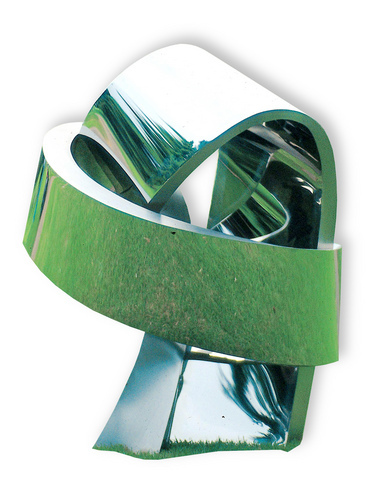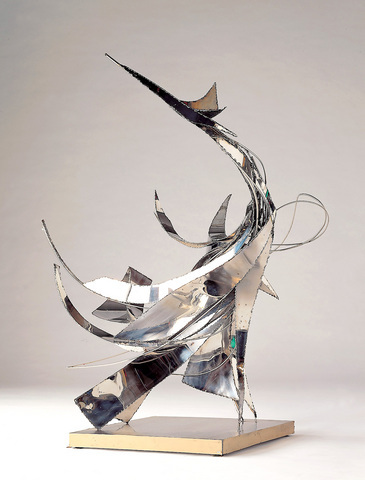At the star-studded gala opening last week of a retrospective exhibition at the Taipei Fine Arts Museum spanning Vivienne Westwood's 30-year career, the popular fashion designer spoke about the wisdom that could be gained from understanding the past.
For an iconoclastic and provocative
designer such as Westwood, the importance of history may seem somewhat of a shock. But Westwood often draws inspiration from classical literature, 18th century French painting, and British history.

Her silk taffeta ball gowns were inspired by Jean-Antoine Watteau paintings, while a beaded Queen of Sheba dress exudes eroticism with its intricate hand beading combined with exotic ostrich feathers.
Her tongue-in-cheek re-workings of Harris Tweed into a royal crown and school-girl-inspired outfits transformed traditionally Bri-tish materials into something sexy and lively.
Westwood stated that there is a very fine line between sex appeal and absurdity, and her work wryly hovers within these boundaries. Her breadth of appeal perhaps explained the very long lines of diverse visitors that ranged from young punk-style teens to elderly couples.

PHOTOS COURTESY OF THE TAIPEI FINE ARTS MUSEUM
Westwood started out designing punk fashion in the 1970s, and unfortunately the exhibition does not provide much insight or background into the social conditions that provoked this movement, so it may give the local viewer the sense that punk was more of a fashion style rather than a revolt against societal values. Whether working with Keith Haring designs, rakish pirate trousers, ripped punk T-shirts, pagan-style printed georgette togas, fake ermine tippets, and corsets, all the fashion items on display do not look dated at all.
In one of the documentary videos on view, Westwood says, "When you analyze where the glamour is in clothes, the romance, it is, I believe, in something that people have seen before."
Westwood's genius derives from her ability to capture the essence of sex and romance in her designs in a way that appears timeless.
Also on display at the Taipei Fine Arts Museum are woodcut prints, oil paintings, bronzes and stainless steel sculptures by famed Taiwanese modernist artist Yang Ying-feng (楊英風, 1926 to 1997).
Yang, born in Yilan, learned calligraphy, painting, architecture and sculpture, not only in Taipei at what is now National Taiwan Normal University, but in Beijing, Tokyo and Rome.
Yang played a crucial role in the
development of early modernism in Taiwan.
Modernism, an art movement of the early 20th century, combined Oriental elements with Western aesthetics.
Yang is famed for introducing an international vocabulary of aesthetics and combining it with Taiwan's local cultural sensibilities. For this retrospective of Yang's work, over 90 of his creations are on view.
The Advent of the Phoenix is one of his more well-known works, comprised of shiny stainless steel that appears like sharp wings, ready to take flight. To Yang, the phoenix was one of the most important symbols signifying both nature and the universe.
An earlier bronze of a water buffalo symbolizes Taiwan's agricultural way of life.
In addition to his sculptures, Yang was adept at printmaking, especially in the traditional craft of woodcutting.
His Self-Portrait (1950) is graphically sharp, while his other prints give a glimpse into what life was like here half a century ago.
Going to the shows:
What: Vivienne Westwood Retrospective
Where: Taipei Fine Arts Museum, 181, Zhongshan North Road, Sec 3, Taipei (
Telephone: (02) 2595 7656
When: Sept. 1 to Oct. 19
What: Yang Ying-feng (
Where: Taipei Fine Arts Museum, 181, Zhongshan North Road, Sec 3, Taipei (
Telephone: (02) 2595 7656
When: To Nov. 13

May 11 to May 18 The original Taichung Railway Station was long thought to have been completely razed. Opening on May 15, 1905, the one-story wooden structure soon outgrew its purpose and was replaced in 1917 by a grandiose, Western-style station. During construction on the third-generation station in 2017, workers discovered the service pit for the original station’s locomotive depot. A year later, a small wooden building on site was determined by historians to be the first stationmaster’s office, built around 1908. With these findings, the Taichung Railway Station Cultural Park now boasts that it has

The latest Formosa poll released at the end of last month shows confidence in President William Lai (賴清德) plunged 8.1 percent, while satisfaction with the Lai administration fared worse with a drop of 8.5 percent. Those lacking confidence in Lai jumped by 6 percent and dissatisfaction in his administration spiked up 6.7 percent. Confidence in Lai is still strong at 48.6 percent, compared to 43 percent lacking confidence — but this is his worst result overall since he took office. For the first time, dissatisfaction with his administration surpassed satisfaction, 47.3 to 47.1 percent. Though statistically a tie, for most

Six weeks before I embarked on a research mission in Kyoto, I was sitting alone at a bar counter in Melbourne. Next to me, a woman was bragging loudly to a friend: She, too, was heading to Kyoto, I quickly discerned. Except her trip was in four months. And she’d just pulled an all-nighter booking restaurant reservations. As I snooped on the conversation, I broke out in a sweat, panicking because I’d yet to secure a single table. Then I remembered: Eating well in Japan is absolutely not something to lose sleep over. It’s true that the best-known institutions book up faster

In February of this year the Taipei Times reported on the visit of Lienchiang County Commissioner Wang Chung-ming (王忠銘) of the Chinese Nationalist Party (KMT) and a delegation to a lantern festival in Fuzhou’s Mawei District in Fujian Province. “Today, Mawei and Matsu jointly marked the lantern festival,” Wang was quoted as saying, adding that both sides “being of one people,” is a cause for joy. Wang was passing around a common claim of officials of the People’s Republic of China (PRC) and the PRC’s allies and supporters in Taiwan — KMT and the Taiwan People’s Party — and elsewhere: Taiwan and